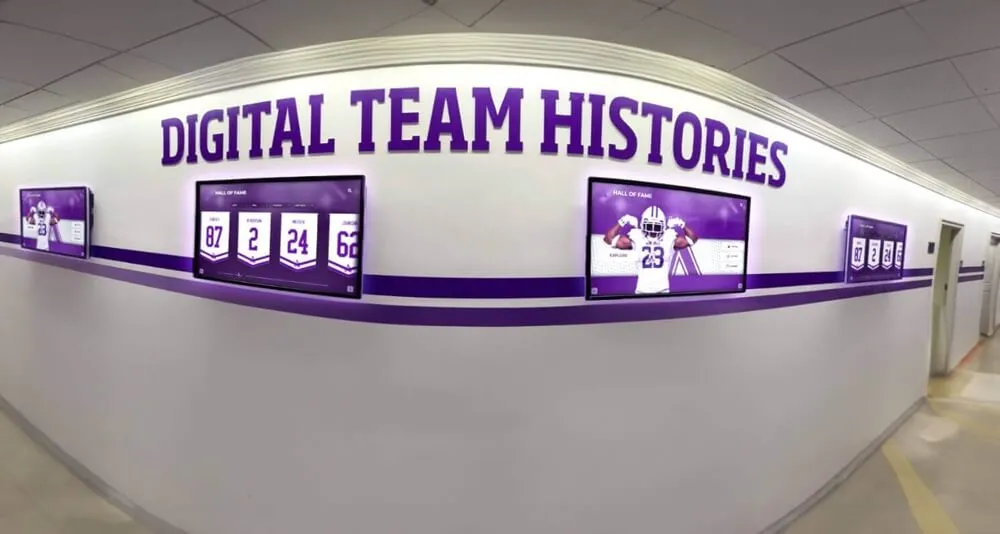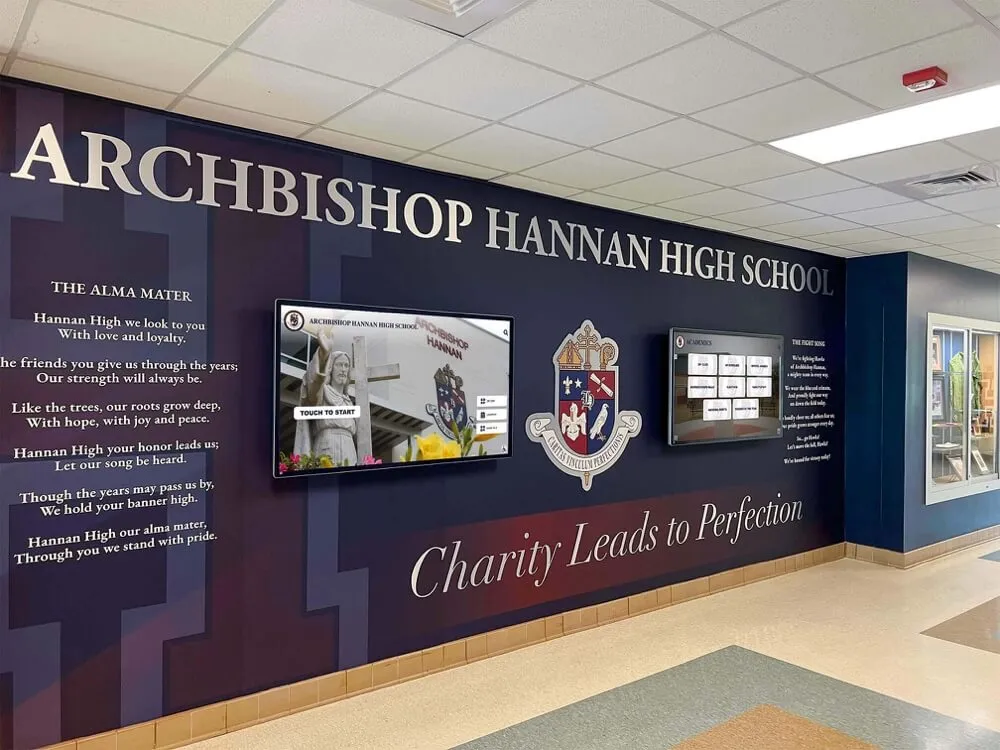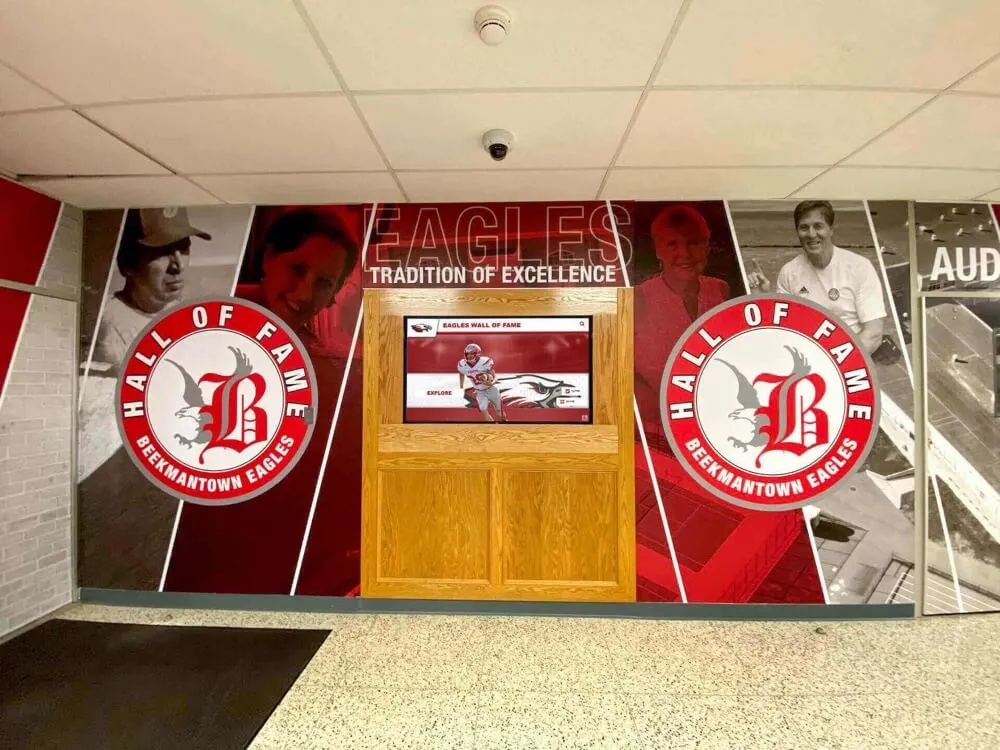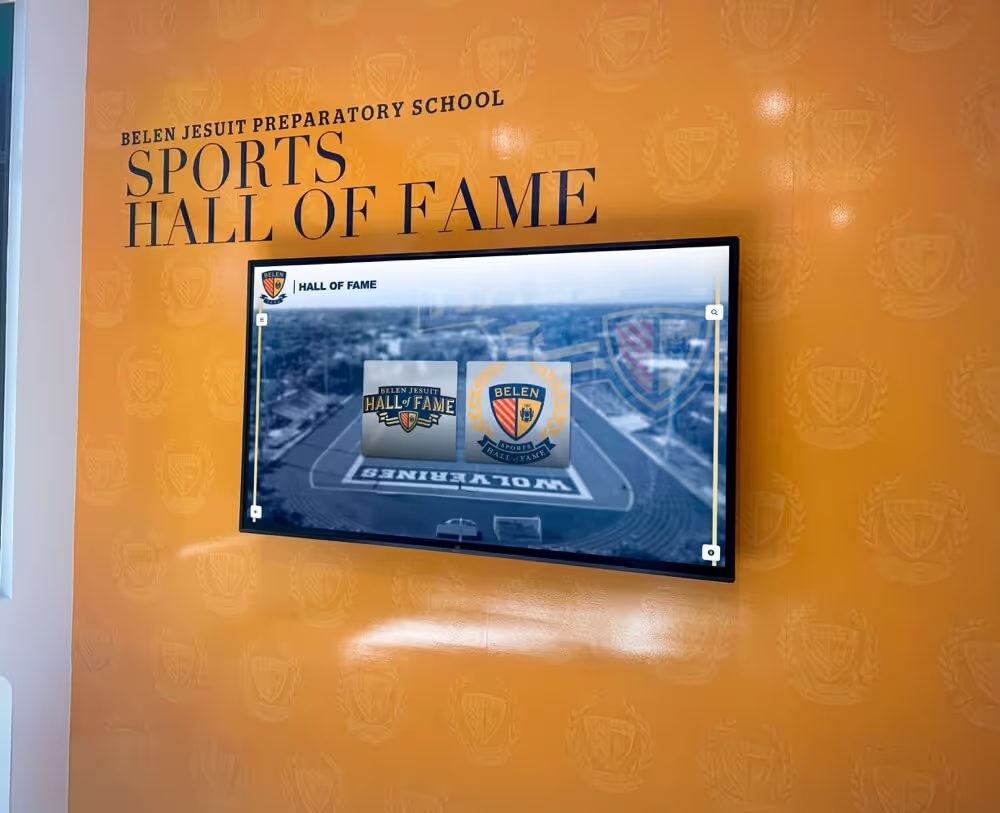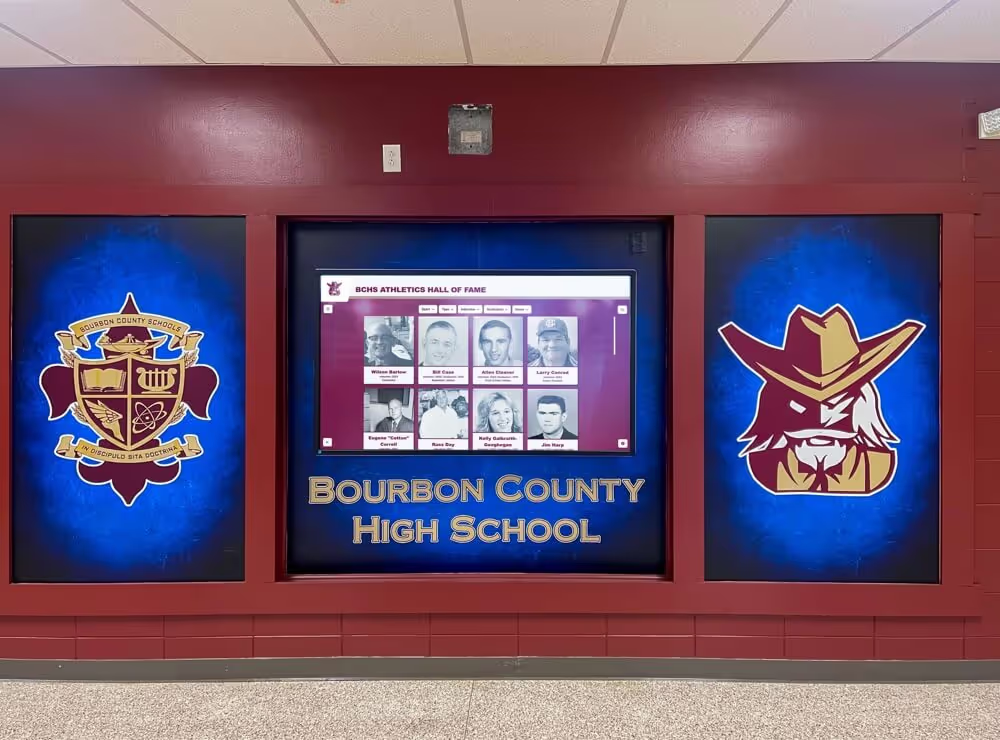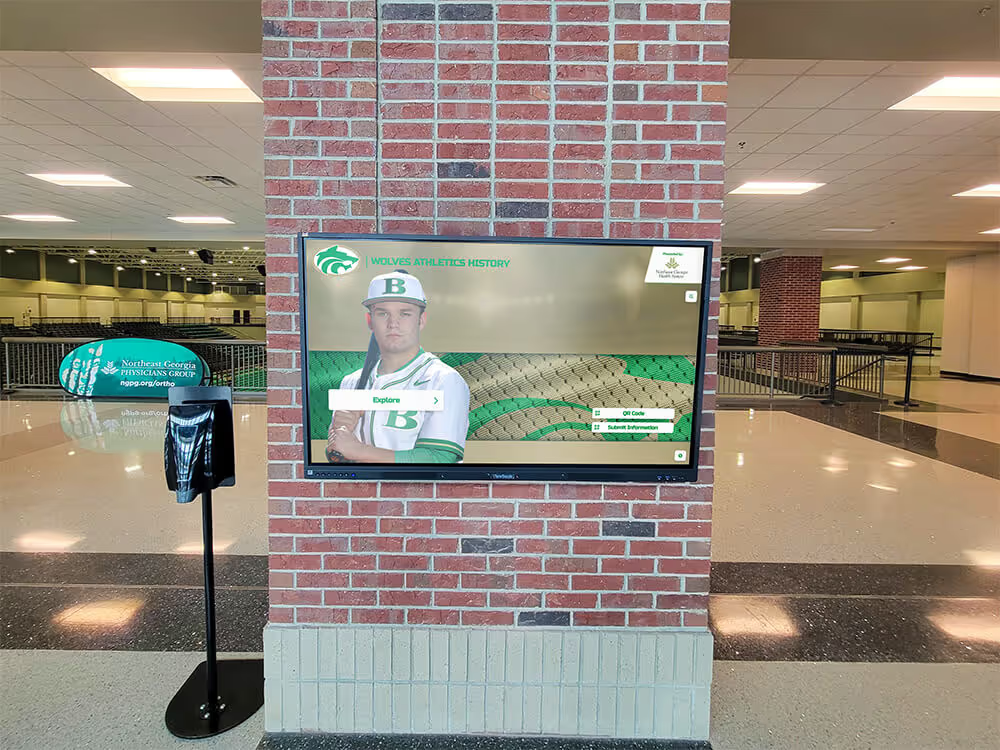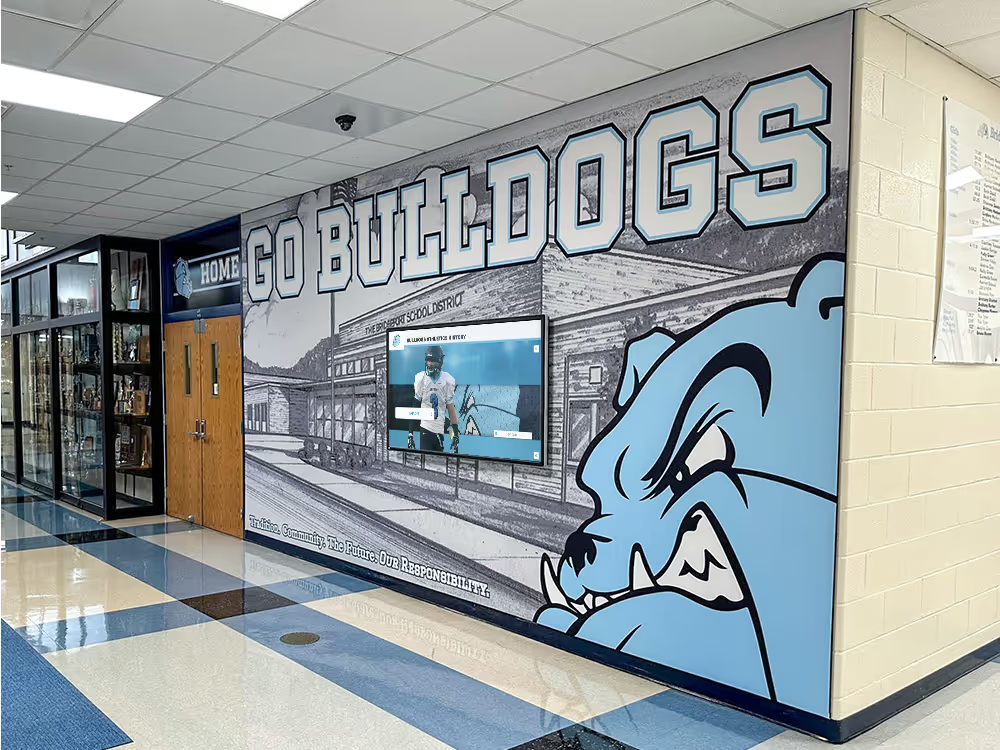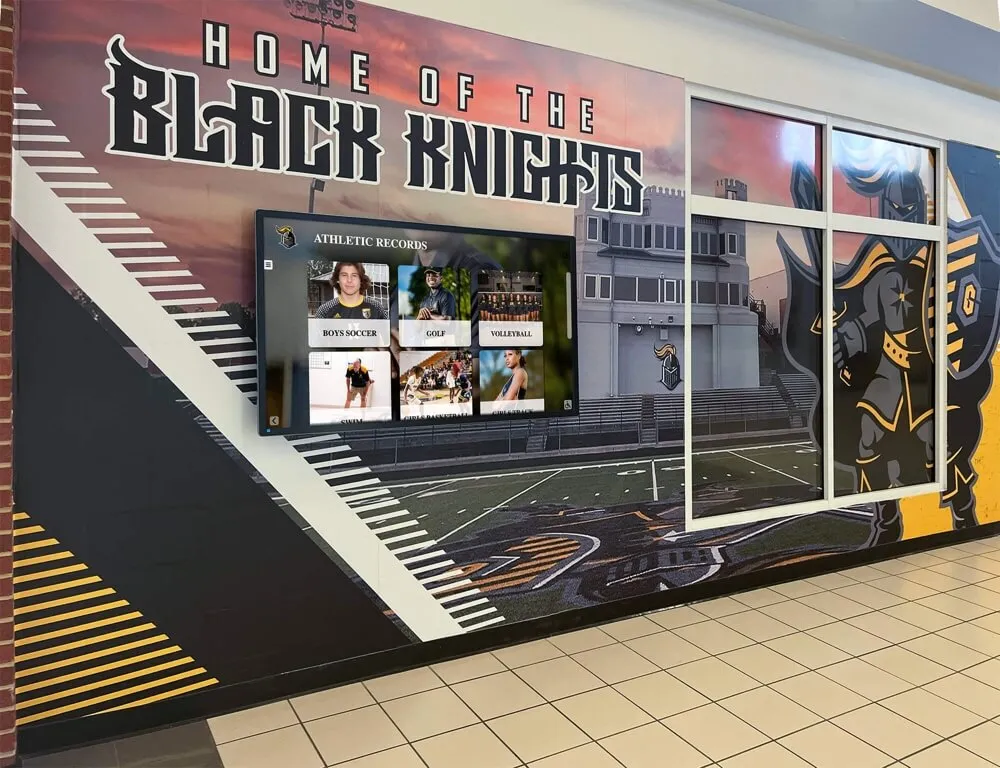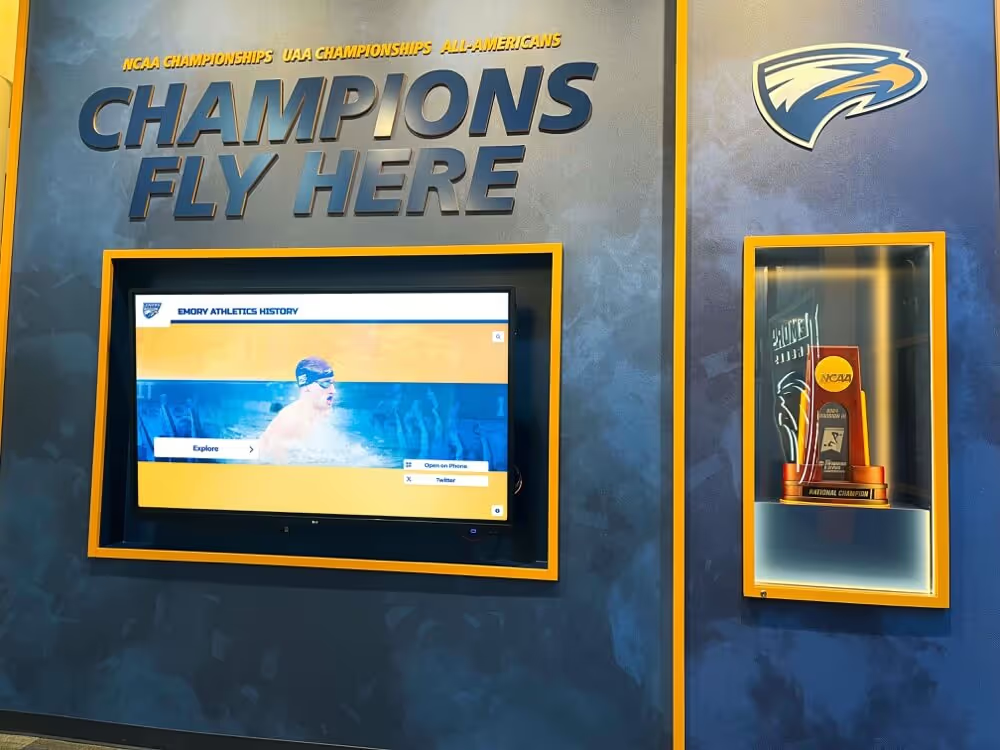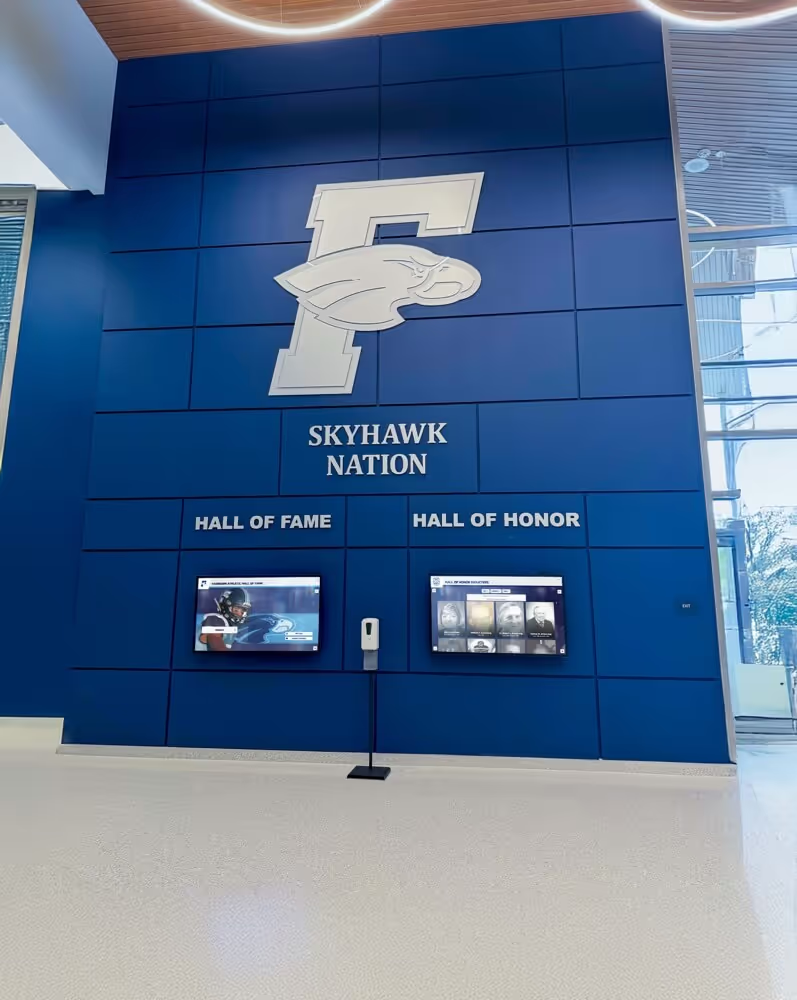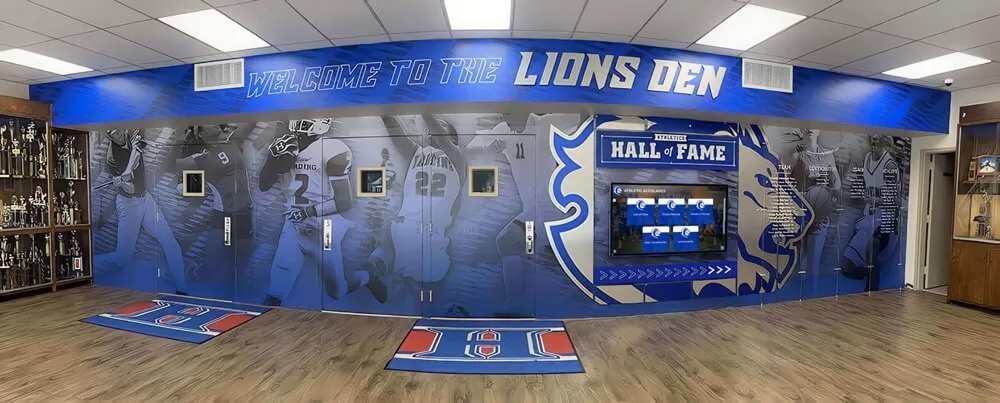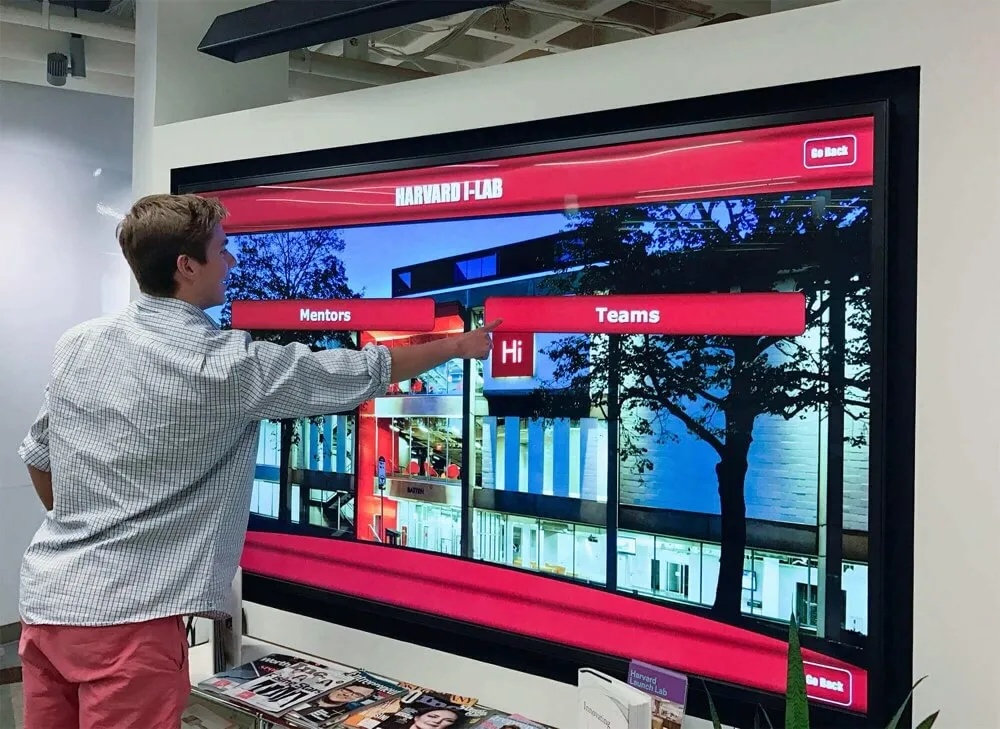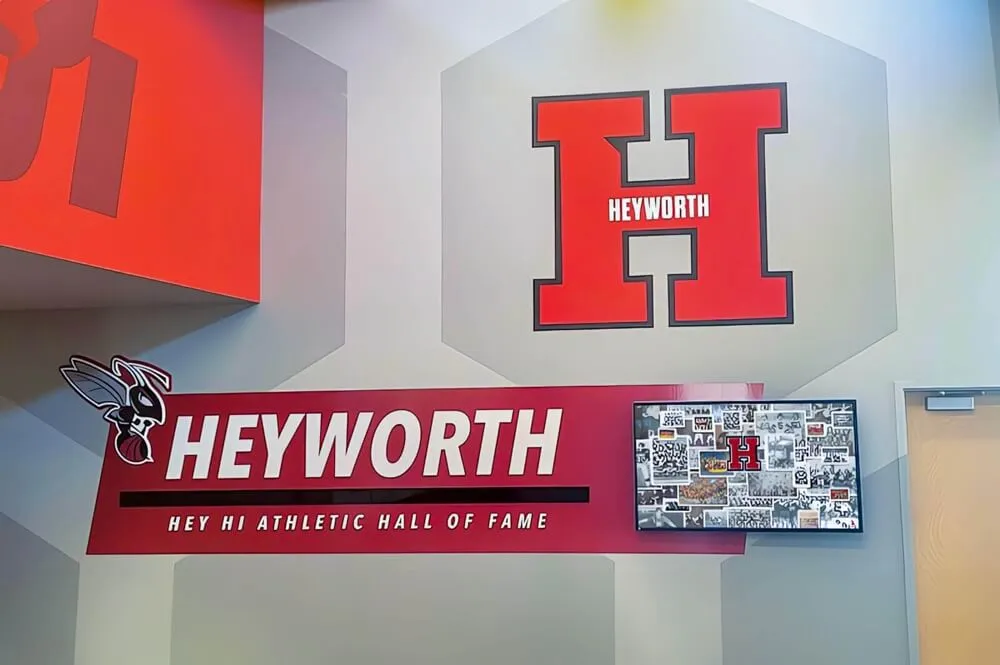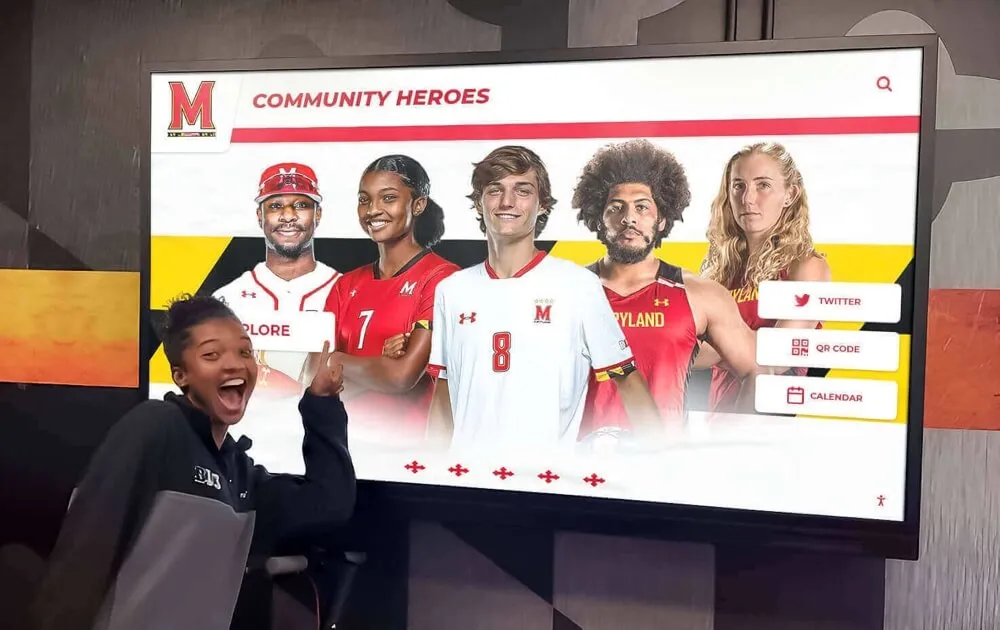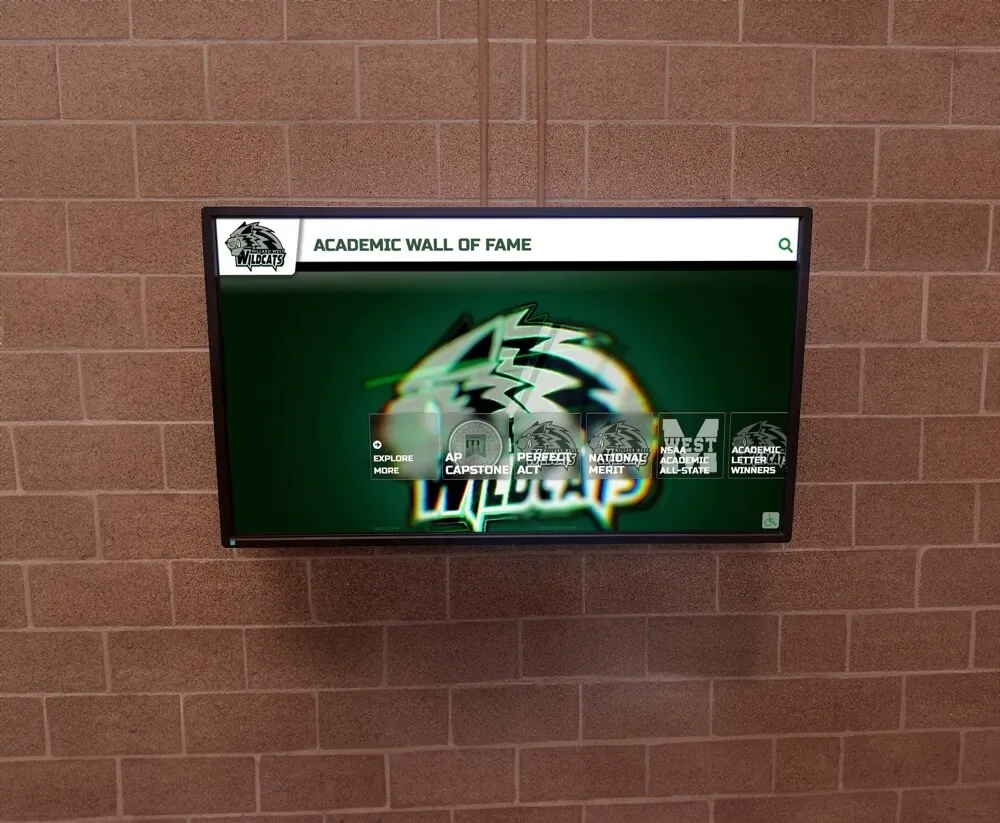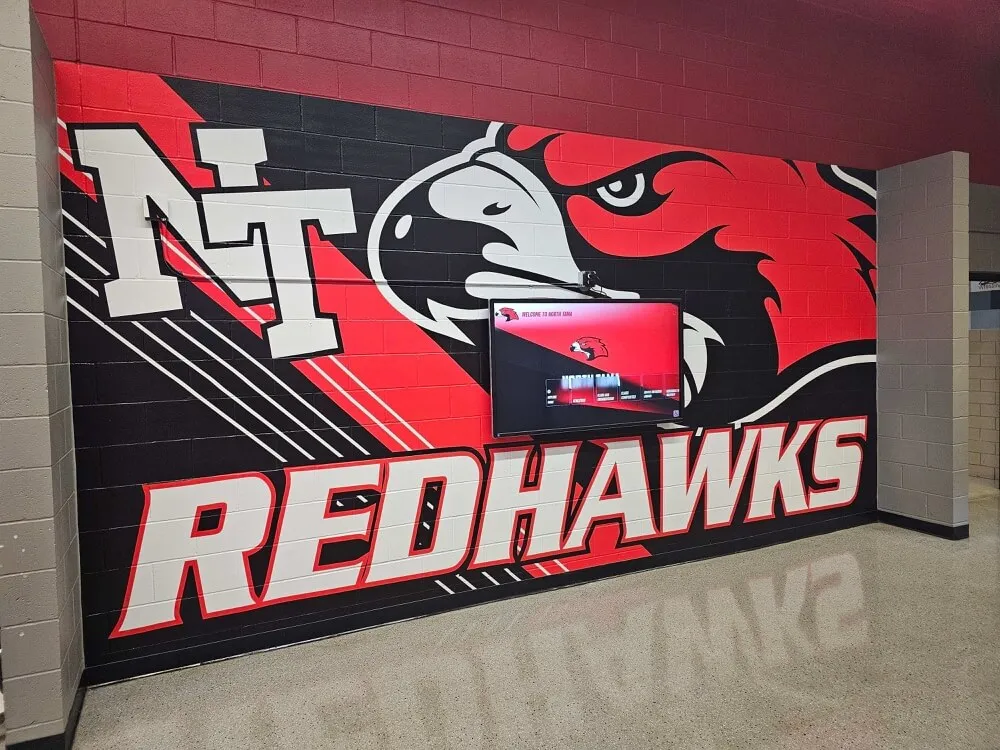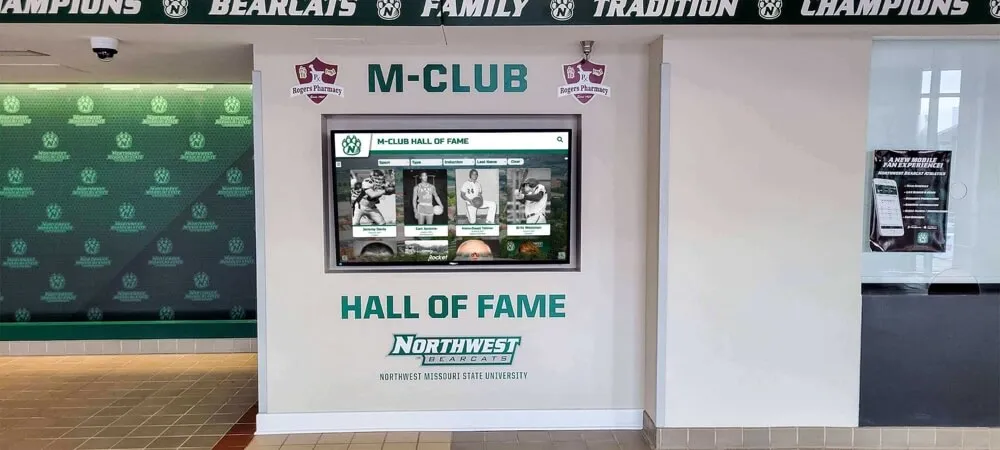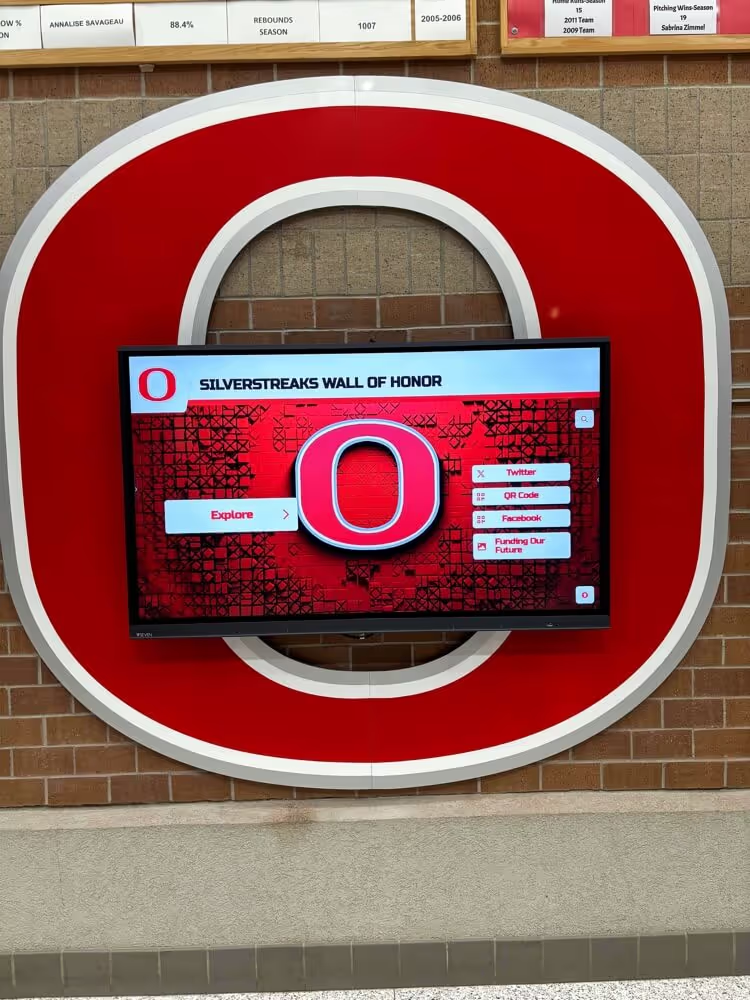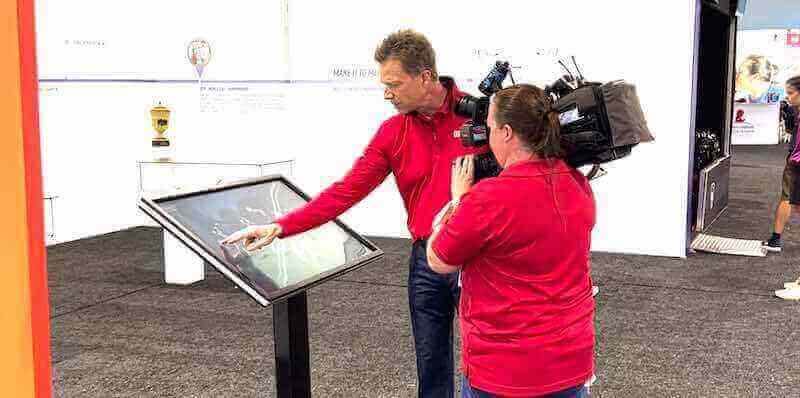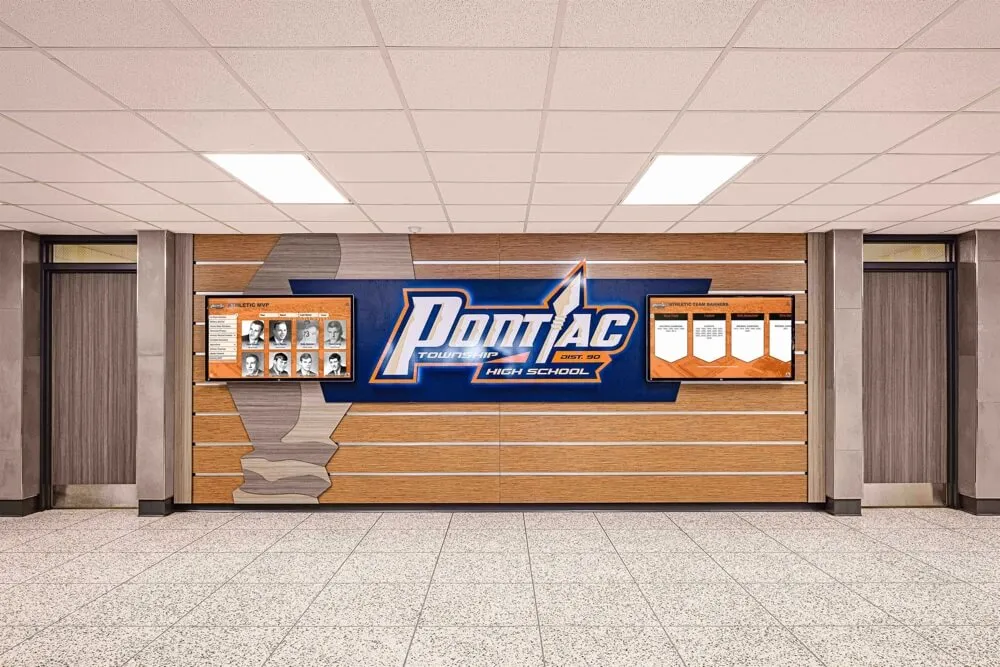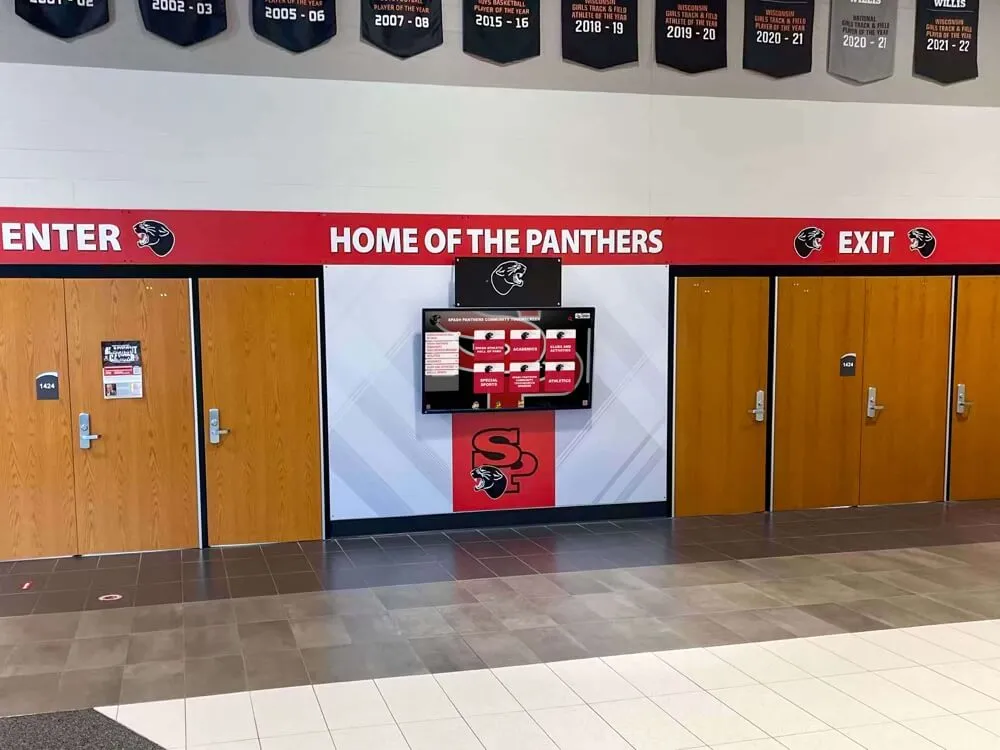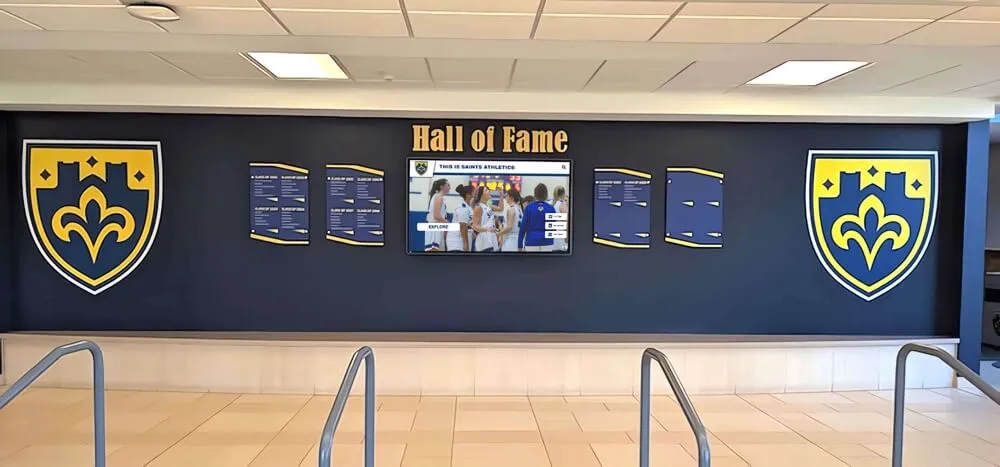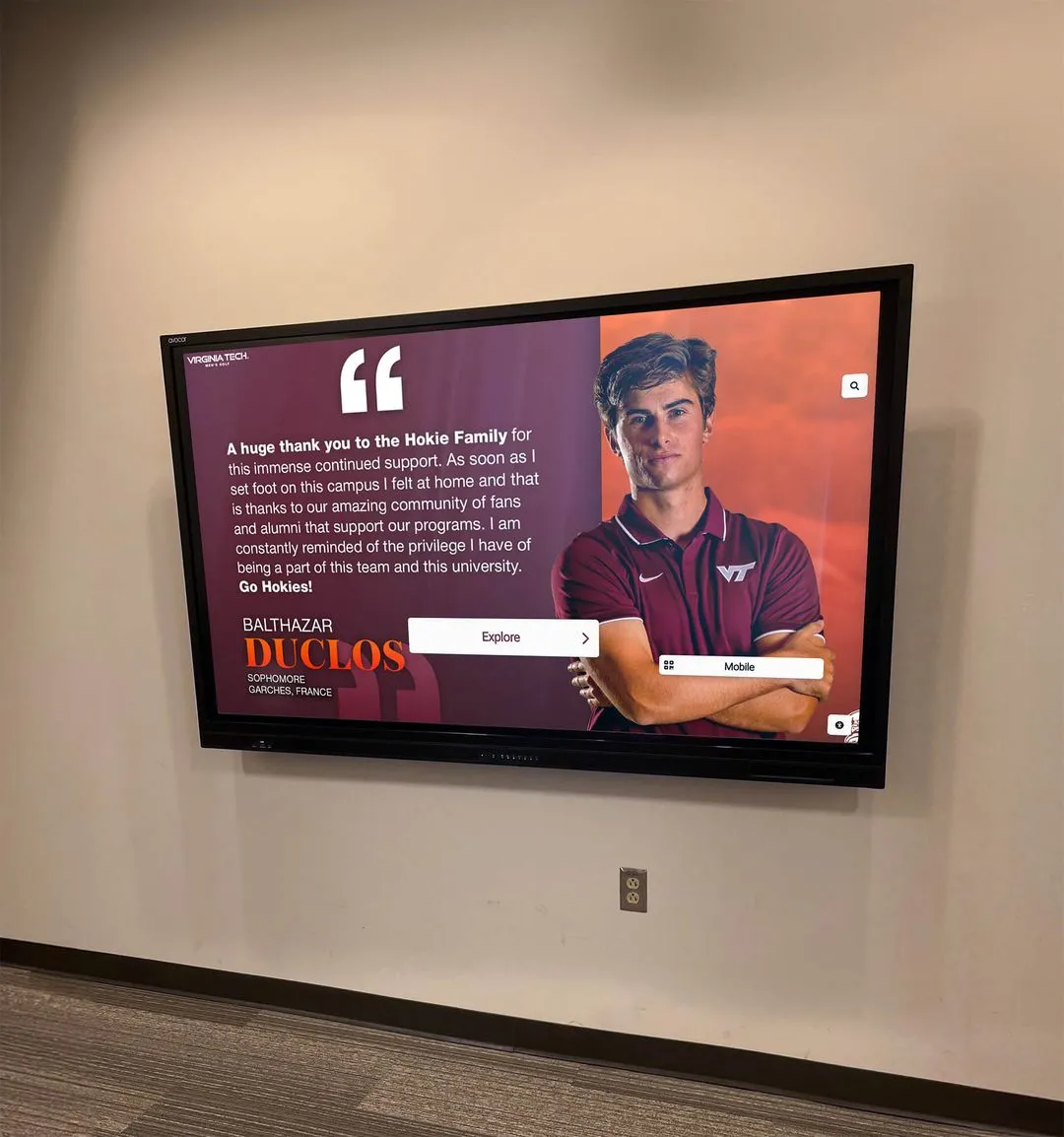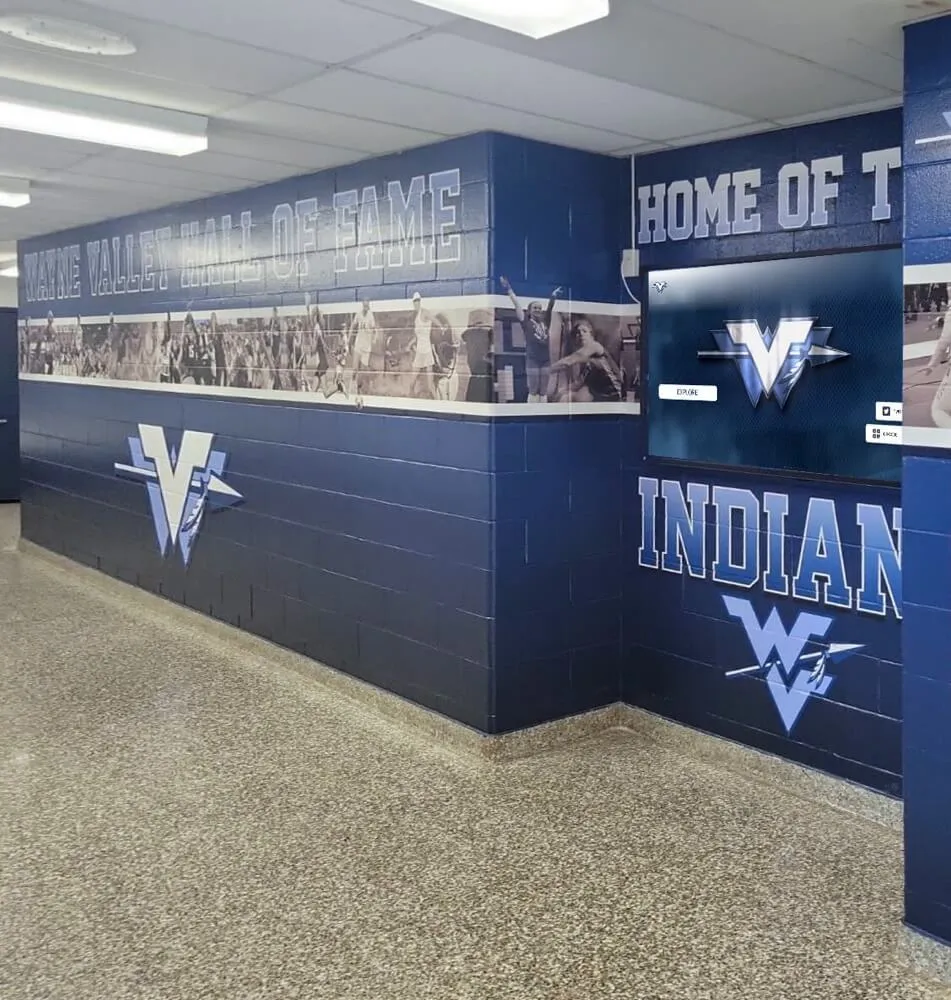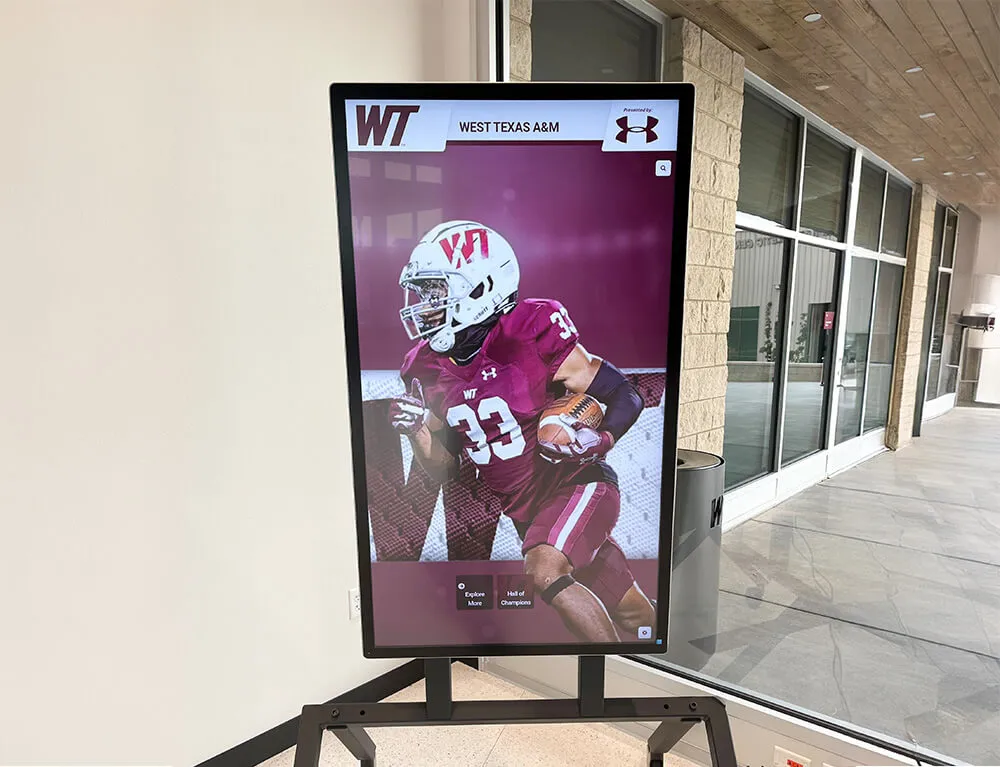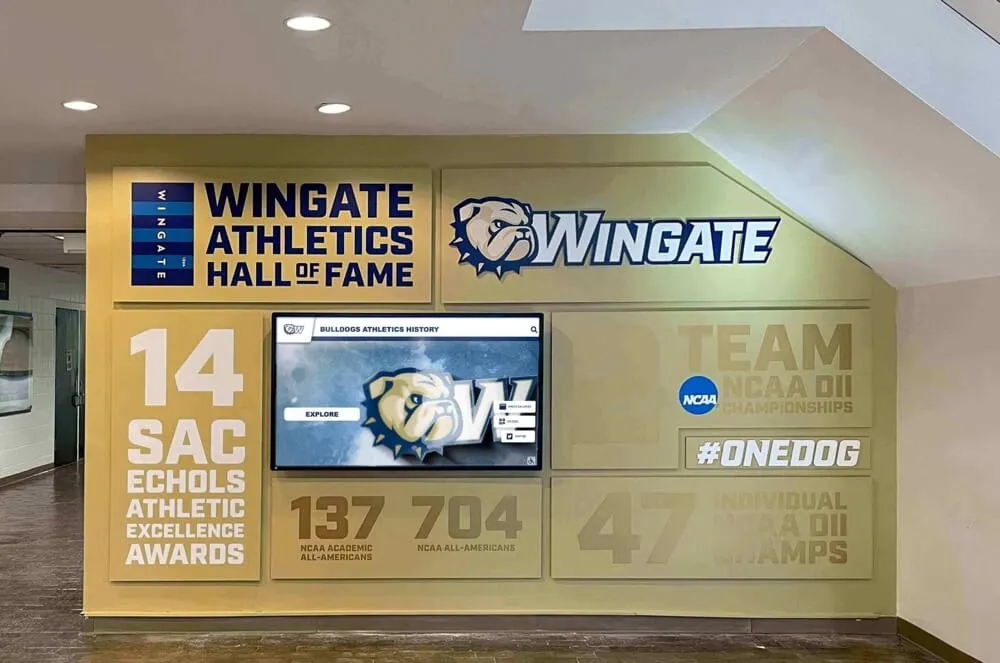The Next Wave of Recognition Technology
The digital halls of fame is evolving rapidly, moving beyond simple touchscreens to incorporate transformative technologies that create deeply personalized, immersive, and connected recognition experiences. As educational institutions and organizations seek more engaging ways to honor achievements, technology innovators are developing solutions that will fundamentally change how we interact with institutional legacies.
Recognition technology stands at the threshold of dramatic transformation. While today’s touchscreen halls of fame represent a significant advancement over traditional trophy cases, the coming generation of interactive alumni displays will leverage emerging technologies to create experiences that are more intuitive, engaging, and accessible than ever before.
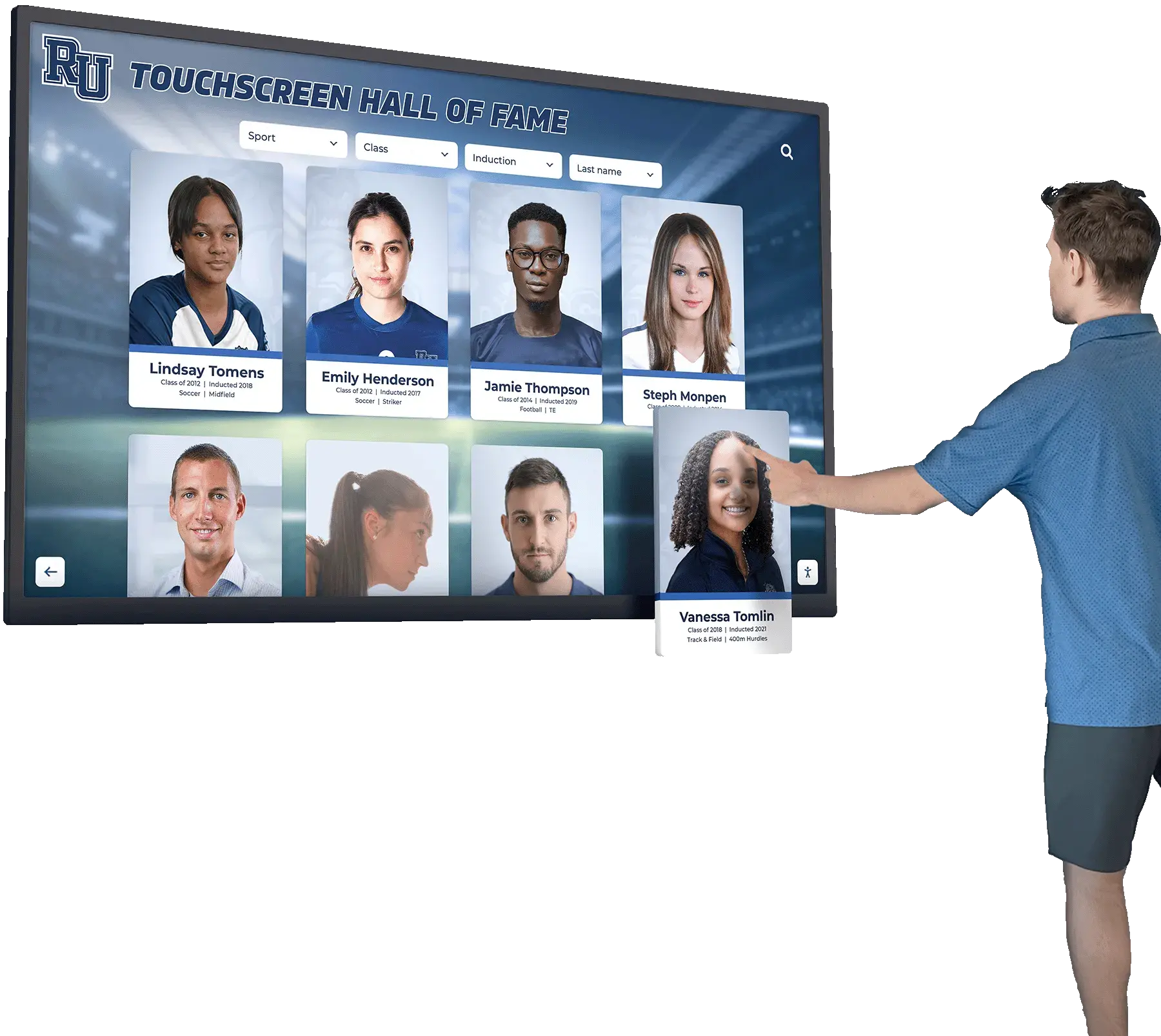
Next-generation touchscreen hall of fame systems incorporate AI-driven interaction, advanced visual recognition, and personalized experiences
Let’s explore the seven transformative technologies that will define the future of digital recognition:
1. Artificial Intelligence: From Static Display to Intelligent Guide
AI is rapidly transforming touchscreen halls of fame from passive information repositories into interactive knowledge systems that actively engage with users:
Conversational AI Interfaces
Future recognition displays will incorporate natural language processing that enables visitors to have human-like conversations about institutional achievements:
- Ask detailed questions about specific achievements
- Explore connections between different honorees
- Receive personalized tours based on stated interests
- Access deeper context and storytelling on demand
- Interact through voice without physical touch
Intelligent Content Management
AI systems will revolutionize how recognition content is organized and presented:
- Automatic identification of relationships between achievements
- Dynamic content curation based on visitor demographics
- Automated enhancement of historical photos and recordings
- Intelligent tagging and categorization of content
- Predictive analytics to highlight relevant achievements
These AI capabilities will make digital walls of fame more engaging by creating dynamic, customized experiences without requiring additional administrative effort. Institutions can automatically generate compelling narratives that connect past achievements with present initiatives, creating more meaningful recognition experiences.
2. Extended Reality: Beyond the Screen Experience
The boundary between physical and digital recognition will increasingly blur through extended reality technologies:
Extended Reality Applications in Recognition
Augmented Reality Enhancements
- Mobile AR companions to physical displays
- Historical context overlays in campus locations
- Dynamic visualization of sports achievements
- Geographic visualization of alumni impact
- Interactive timelines with spatial components
Virtual Reality Experiences
- Remote access to recognition displays
- Immersive first-person achievement recreations
- Virtual alumni gatherings in recognition spaces
- Historical campus tours across time periods
- 360° capture of significant moments and spaces
These technologies will be particularly valuable for alumni engagement, allowing graduates anywhere in the world to virtually “visit” their alma mater’s recognition displays and interact with them as if physically present. For current students, extended reality creates powerful connections to institutional history by bringing past achievements to life in compelling ways.
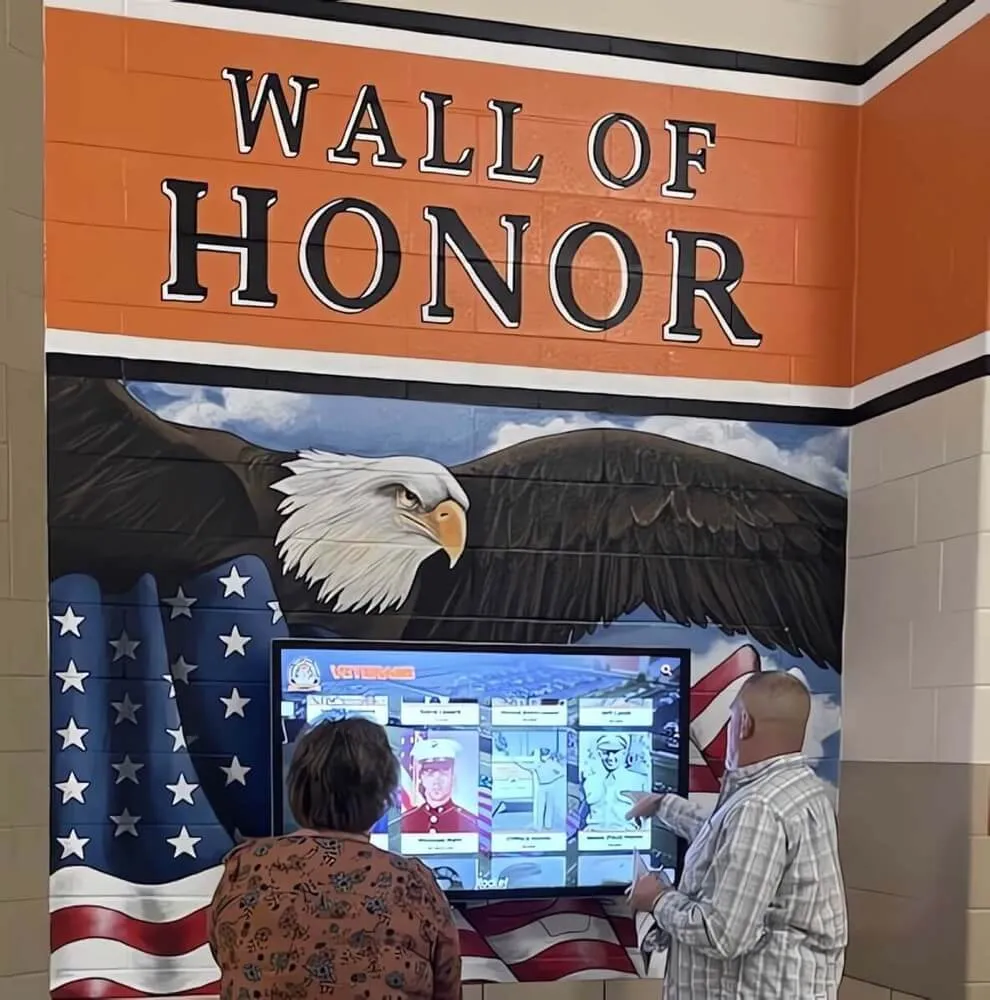
Augmented reality overlay showing a historical athletic achievement visualization at Seneca East High School's digital recognition display
3. Case Study: Tomorrow Academy’s Future-Ready Recognition System
Tomorrow Academy is pioneering next-generation recognition technology with their “Living Legacy Lab”:
"We've created what we call a 'Living Legacy Lab' where we're experimenting with emerging technologies for our digital halls of fame. Our most successful implementation combines AI-driven storytelling with augmented reality. Visitors can have natural conversations with our display about any achievement, then use AR to explore related artifacts in 3D. The engagement metrics have been extraordinary—visitors spend an average of 17 minutes interacting with the system versus just 2 minutes with our previous touchscreen."
— Dr. Elizabeth Chen, Director of Innovation, Tomorrow Academy
Their pioneering implementation includes:
- AI system trained on 75 years of institutional history
- Holographic recreations of significant performances and events
- Blockchain-verified achievement records
- Biometric personalization of visitor experiences
- Remote access capabilities for global alumni engagement
Tomorrow Academy reported a 340% increase in alumni engagement with their recognition program after implementing these technologies, demonstrating the significant potential impact of next-generation systems.
4. IoT and Ambient Intelligence: The Always-Aware Display
Smart, connected environments will transform how touchscreen halls of fame interact with their surroundings and visitors:
Proximity-Based Personalization
Visitor Recognition
Displays will recognize returning visitors through mobile devices or opt-in biometrics, customizing content based on previous interests and interactions.
Contextual Awareness
Systems will detect visitor demographics and adjust content presentation accordingly, highlighting relevant achievements for different audience segments.
Multi-User Coordination
Connected displays will coordinate content across multiple users, enabling collaborative exploration and group-optimized experiences.
Environmental Adaptation
Future digital walls of fame will respond intelligently to environmental conditions:
- Event-Aware Content: Automatic content emphasis during relevant events (highlighting sports achievements during game days)
- Traffic-Responsive Interface: Adjustment between deep exploration and high-level browsing based on visitor flow
- Time-Sensitive Highlighting: Featuring anniversary-related achievements on significant dates
- Ambient Condition Adaptation: Adjustment of brightness, volume, and interaction zones based on environmental factors
These connected capabilities will make recognition displays feel more responsive and alive, creating the sense that the system actively participates in the celebration of achievements rather than passively displaying them.
5. Blockchain and Distributed Technologies: Secure, Verified Recognition
Emerging verification technologies will create new trust models for achievement recognition:
Blockchain Applications in Recognition Systems
Immutable Achievement Records
- Cryptographically secured recognition verification
- Permanent historical record immune to tampering
- Transparent selection criteria and processes
- Public verification of achievement authenticity
- Integration with digital credential systems
Community Contribution Systems
- Decentralized content submission and validation
- Alumni-verified historical information
- Reputation-based content contribution systems
- Cross-institutional achievement verification
- Transparent governance of recognition systems
These technologies will be particularly valuable for establishing the authenticity of historical achievements and creating trustworthy systems for ongoing recognition. For institutions with rich histories, blockchain offers a solution to the challenge of verifying achievements from eras with limited documentation.
6. Biometric Interface Technologies: Intuitive, Natural Interaction
The way visitors interact with recognition displays will become increasingly natural through biometric interfaces:
Gesture-Based Navigation
Motion-controlled interfaces will eliminate traditional barriers to interaction:
- Touchless Control: Navigating content without physical contact
- Spatial Exploration: Using natural movements to browse timelines and categories
- Gesture Shortcuts: Intuitive movements to filter and sort content
- Collaborative Viewing: Multiple visitor synchronized exploration
- Accessibility-Enhanced Gestures: Customized motion detection for users with different abilities
Emotional Response Integration
Next-generation systems from Rocket Alumni Solutions will respond to visitor reactions:
Engagement Optimization
- Detection of interest levels through facial expression
- Content depth adjustment based on engagement signals
- Additional detail provided for high-interest items
- Recognition of confusion or difficulty navigating
- Proactive assistance when users appear lost
Emotional Impact Measurement
- Anonymized tracking of emotional responses to content
- Identification of most emotionally impactful achievements
- Recognition of nostalgic connections to specific eras
- Detection of collective emotional responses in groups
- Adaptation to create more meaningful experiences
These emotional intelligence capabilities will help recognition systems fulfill their core purpose more effectively by creating stronger emotional connections between visitors and institutional achievements. The result will be more memorable, impactful recognition experiences.
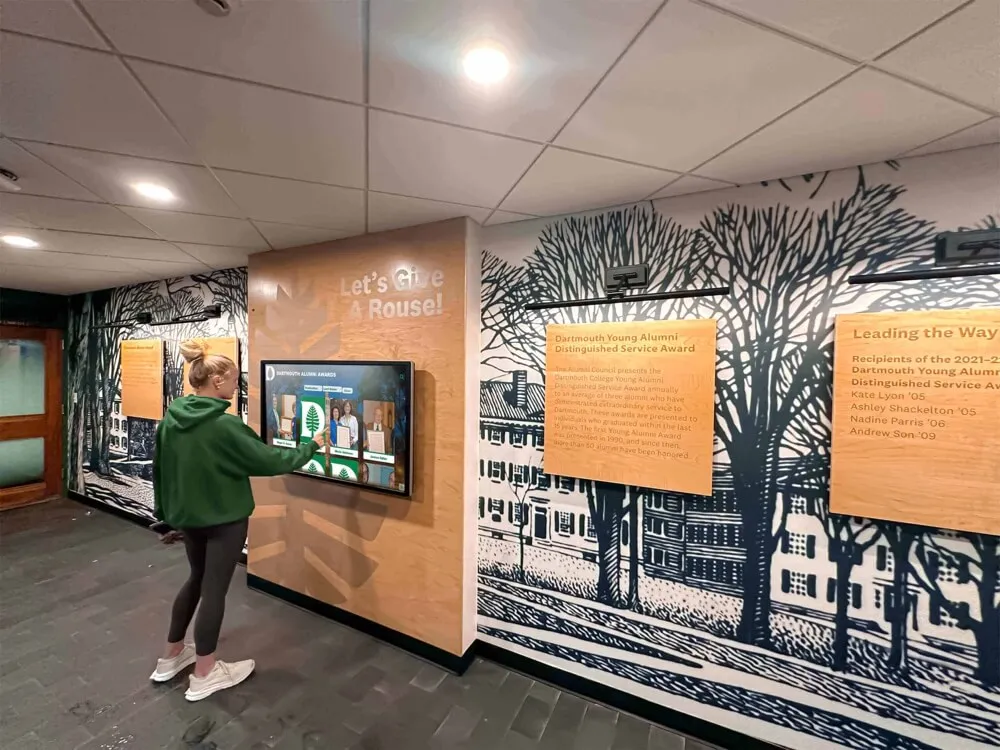
Dartmouth's prototype using gesture recognition technology allowing touchless navigation of their athletic achievement archives
7. Advanced Data Visualization: Making Achievement Impact Visible
Sophisticated visualization technologies will transform how achievements are contextualized and understood:
Dynamic Network Mapping
Visual representation of connections and influence:
Network Visualization Applications
Achievement Relationship Mapping
- Visualizing connections between related accomplishments
- Showing mentor-mentee relationships across generations
- Mapping collaborative achievements and team dynamics
- Illustrating the evolution of programs and departments
- Highlighting interdisciplinary connections and influence
Impact Flow Analysis
- Tracing the influence of achievements over time
- Visualizing how accomplishments inspire future success
- Mapping institutional impact on industries and fields
- Showing geographic spread of alumni contributions
- Illustrating the growth of recognition categories
Temporal-Spatial Visualization
Achievements will be placed in rich historical and geographic context:
- 4D Timeline Navigation: Exploring achievements across both time and location simultaneously
- Historical Context Integration: Situating institutional achievements within broader historical events
- Geographic Impact Visualization: Mapping the global influence and reach of recognized individuals
- Predictive Legacy Modeling: Projecting the continuing impact of achievements into the future
- Comparative Institutional Analysis: Benchmarking achievements against peer organizations
These visualization capabilities will help visitors understand not just what was achieved, but why it matters and how it connects to the broader institutional mission and impact.
Implementation Considerations for Future Technologies
Institutions planning for next-generation recognition systems should consider these key factors:
Scalable Architecture
Deploy systems with flexible technical foundations that can incorporate emerging technologies without complete replacement.
Data Standardization
Establish structured information formats that will support AI applications and cross-platform integration in the future.
Privacy Framework
Develop comprehensive policies for biometric data, personal information, and user tracking before implementing advanced features.
Digital Preservation
Create robust strategies for long-term content access that will survive multiple technology transitions.
Inclusive Design
Ensure advanced technologies enhance rather than limit accessibility for users with different abilities.
Ethical Guidelines
Establish clear principles for using AI, emotion detection, and personalization technologies in recognition contexts.
A thoughtful approach to these considerations will help institutions implement future technologies in ways that enhance recognition while respecting important values and constraints.
Preparing for the Future of Recognition Today
While some of these technologies are still emerging, forward-thinking institutions can take steps now to prepare for the next generation of digital recognition:
- Content Digitization: Comprehensively digitize historical recognition materials in high-quality, structured formats
- API-First Architecture: Implement recognition systems with open APIs that can integrate with future technologies
- Experimental Pilots: Test emerging technologies in limited applications to build institutional experience
- User Research: Conduct research to understand how different stakeholders would value advanced features
- Strategic Planning: Develop a long-term technology roadmap for recognition systems with planned upgrade paths
Future-Proof Your Recognition Program
Rocket Alumni Solutions offers implementation strategies that prepare your touchscreen hall of fame for emerging technologies while delivering immediate impact today.
Conclusion: The Convergence of Recognition and Experience
The future of digital walls of fame lies at the intersection of recognition, storytelling, and immersive experience design. As technology continues to evolve, touchscreen halls of fame will transform from repositories of achievement to dynamic environments that bring institutional legacies to life in increasingly personalized and meaningful ways.
The most forward-thinking institutions recognize that investments in next-generation recognition technology aren’t merely about modernizing displays—they’re about creating powerful new ways for community members to connect with institutional identity, values, and achievements across time and space.
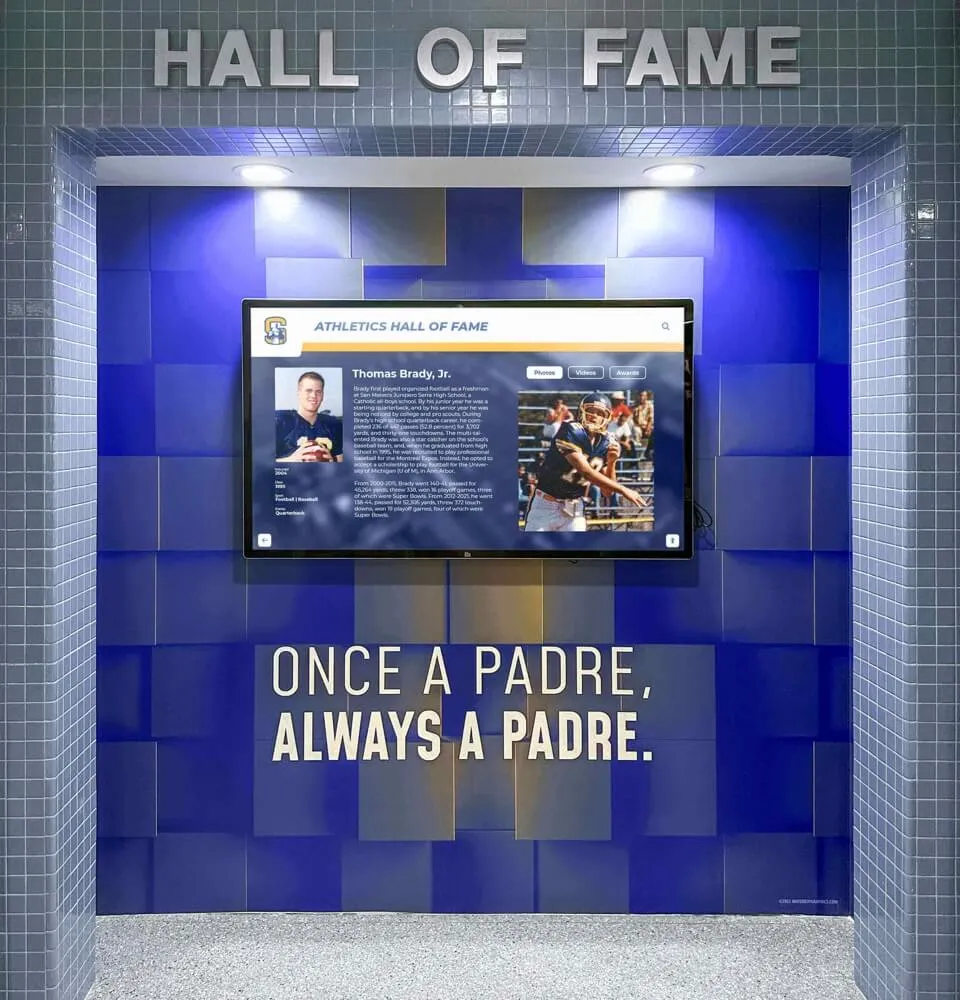
Students at Junipero Serra High School interact with an early implementation of AI-enhanced recognition technology
At Rocket Alumni Solutions, we’re continuously exploring these emerging technologies to ensure our interactive alumni display platforms remain at the cutting edge of recognition innovation. Contact us to discuss how these future trends might be incorporated into your institution’s recognition strategy and how you can begin laying the groundwork for these powerful capabilities today.





